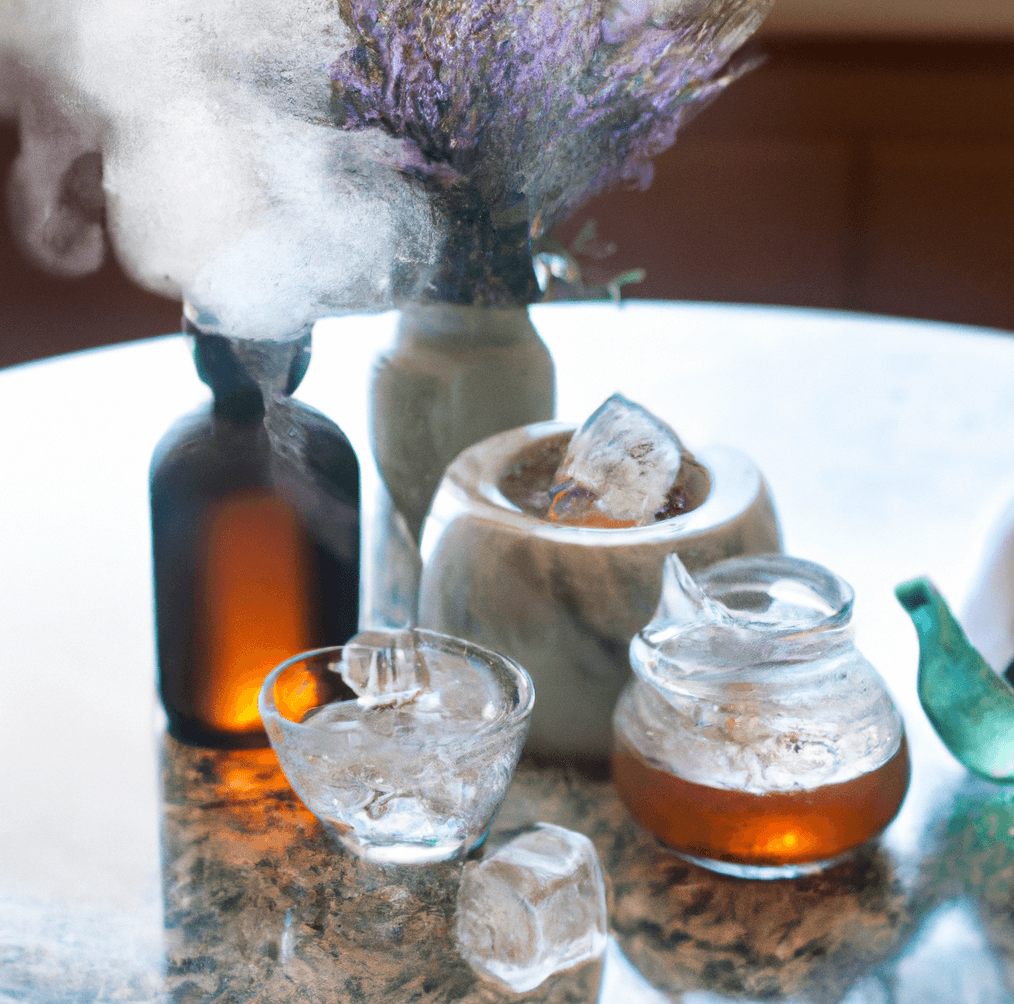The Role of home remedies in migraine management
I firmly believe that home remedies for migraine can be a useful addition to acute treatments and help ease some of the accompanying symptoms. Even more, depending on the frequency and severity of your migraine attacks, they may even completely alleviate all major migraine symptoms. Home remedies can also be helpful during the post-drome phase of a migraine attack, which can leave you feeling exhausted with a tight neck.
As I have shared in previous posts here, my migraine is chronic. Which means I have to handle migraine attacks more than 15 days a month. My migraine pain is also pretty severe, so I have to take one of the acute migraine medications. While I wait for the medication to start working, home remedies make it easier for me to bear the attack and start to reduce some of the symptoms like pressure, throbbing, nausea, and stress.
In this post, I am reviewing five effective home remedies that I have personally researched and routinely use to manage my migraine symptoms. Whether you’re looking for relief from throbbing pain, head pressure, nausea, or stress, these remedies can provide a helpful addition and sometimes an entire alternative to traditional migraine treatments.
Apply pressure and cold to the head/face
One of the things I hate the most about migraine is the throbbing pain and pressure that happens during the attack. This is why I try to apply counterpressure as my first strategy, right after I take my acute medication and drink some water.
There are many ways to apply pressure and cold:
- Put a tight headband or a bandana on.
- Use a cold pack for 5-10 min, followed by a headband or bandana
- At times, when I lie down, I simply use my hands to apply constant pressure on my temple/forehead area until the throbbing starts to wind down.
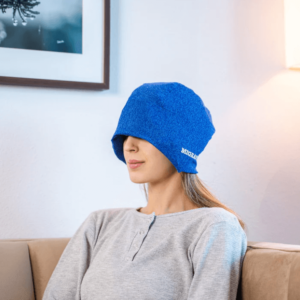
- If your budget allows, you can use one of the products on the market for pressure/cold such as a migraine hat. It is a hat specifically designed to hold ice packs or gel pads and fit snugly around your head during the attack. They range in price anywhere from $15 to $50. You can store it in a Ziplock bag inside your freezer and wear it when you feel a migraine coming on. Here is an example of one that fits most sizes.
- Sometimes you can even use your jade face roller which is usually used for the application of creams and face massage, but feel divine on a hot throbbing face during an attack.
- Keep some of your face sheet masks in the fridge and put one on during the attack. It cools the face while providing hydration for your skin. Not a spa treatment by any means, but you can still benefit from the cold compress.
Often, I combine the cold/pressure application with some breathing and self-relaxation techniques to take the stress level down and divert my attention from the head pain to the rest of my body. But sometimes even the slightest touch is unbearable because the intensity of pain is just too high. For those times, use the strategy below to use water therapy for relief.
Soak feet in hot water followed by 5-min CBD foot rub
A foot soak is one of the easiest and most affordable home remedies for migraine. When I have an acute migraine attack, my feet and hands are cold. I also feel as though my entire body is spasmed and tense from enduring the migraine pain. It is common for circulation in hands and feet to decrease during migraine. This can make our extremities feel cold, numb, and even tingly.
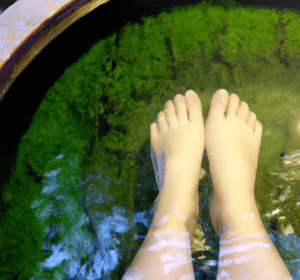
If you are experiencing an acute migraine attack, a hot foot soak can be a great way to increase blood flow to the feet. A foot soak can help to divert blood away from the head and ease the throbbing pain associated with migraines. Additionally, the warm water will help you relax tense muscles and promote overall relaxation. Consider adding Epsom salt to your foot soak to enhance its benefits further.
I follow a 5-10 min foot soak with a quick 5 min foot rub with CBD cream. CBD is now used in many self-care products like oils and creams for its potential health benefits, such as reducing inflammation, relieving pain, and promoting relaxation. Massage with CBD also stimulates the release of endorphins, which are natural painkillers and reduce tension in the body.
I use this super nice and subtle-smelling Muscle and Join CBD Relief Cream from Vital Body Therapeutics. It smells of ginger and cedarwood, instantly calms me, and has the most stress-relieving effect. While I rub my feet with it, it distracts my brain from migraine pain also.
For a more budget-conscious option, I use CBD Daily 1.7 oz Intensive Cream which costs around $13.99. It is pleasantly minty, very moisturizing, and also effective.
There are hundreds of CBD creams on the market. You just need to find one within your price range and the one that smells and feels best to you.
Drink herbal tea with honey to combat nausea and relax your digestive tract.
It is common for digestion to slow down during a migraine attack. This is because migraines can affect the functioning of the autonomic nervous system, which controls many bodily functions, including digestion. In addition, some people with migraines experience nausea and vomiting during an attack, which can further slow down digestion.
One of the easiest home remedies for migraine you can buy to have on hand is some herbal tea for nausea relief. There are many teas on the market that are specifically formulated to provide digestive support. Some of the common ingredients in those teas are ginger, peppermint, and chamomile. But there are many others. You just need to find one that tastes the best to you.
Also, try to eat a spoonful of honey when drinking the tea. Honey has natural antibacterial and anti-inflammatory properties, which can help soothe the stomach and digestive system.
Here are the teas I found to be most helpful in calming down my stomach:
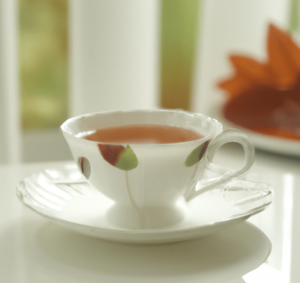
- Pukka Three Ginger Tea – This tea is made with three types of ginger to help soothe nausea.
- Traditional Medicinals Organic Peppermint Tea – Peppermint has been shown to calm the upset stomach and relieve tension.
- Bigelow Lavender Chamomile Tea – Lavender and chamomile have calming properties.
- Harney & Sons Organic Green Tea with Coconut – Green tea contains caffeine, which can help relieve headaches, and the coconut adds a touch of sweetness.
If tea is not your thing, no worries. There are other ways to combat nausea and lift your spirits up at the same time. Read the section below for the use of aromatherapy in alleviating these bothersome migraine symptoms.
Apply peppermint and lavender essential oils
Another affordable home remedy for migraine is aromatherapy in the form of therapeutic grade, 100% organic essential oils. Lavender and Peppermint essential oils are my go-tos for migraine management:
- Peppermint can reduce nausea and provide a cooling sensation for hot, throbbing temples. It also creates mental clarity and reduces stress.
- Lavender has a tranquil aroma that can reduce stress and tension.
Have them in your home remedy cabinet and be ready to apply when you feel the migraine coming on. True pure essential oils are potent and should be handled with care because if used improperly they can irritate your skin and eyes. That is why I recommend using them in a way that minimizes those risks and keeps things safe.
I use both oils in the following ways to combat my migraine symptoms:
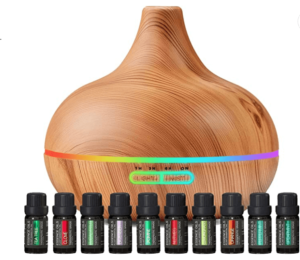
- Another popular and easy on-the-go option is to use a roll-on. I use this simple roll-on when I am traveling or happen not to be home when the migraine strikes. Simply carry it in your purse. The cost of these roll-ons is between $10 and $20. I found many great options at around $13-14. It will easily last several months or more, depending on migraine frequency.
- Use them in your essential oil mister like this one that I got from Amazon. It even comes with 10 therapeutic-grade essential oils as part of the set, including peppermint and lavender.
- Mix a few drops of both or one of the oils into a carrier oil like almond or jojoba oil and use to gently rub the temples, feet, and neck
- You can also mix a few drops into a cup of Epsom salt and simply add to the foot soak
- Let a few drops fall onto the shower floor and get a steam shower. The aromas instantly lift my mood up and help with all the emotions that come with a migraine attack
Other essential oils to consider adding to your home remedies for migraine set are cedarwood, rosemary, and eucalyptus.
Consider a basic magnesium supplement to ease the pain
According to American Migraine Foundation, it’s believed that magnesium can prevent the brain signaling that causes visual and sensory changes associated with aura. It can also reduce or block pain-transmitting chemicals in the brain and may be helpful for brain blood vessels.
Generally, magnesium is very safe. It might cause diarrhea. In that case, the dose should be decreased.
Here is my experience with taking magnesium supplements to ease migraine pain.
- I feel a lot more relaxed and less anxious from pain.
- It makes me slightly sleepy, so I would prepare not to drive or operate anything.
- It takes the edge off my pain.
There are literally hundreds of magnesium supplements that are available over the counter and in your local pharmacy. Many contain additional vitamins and herbs that were specifically formulated for migraine relief.
A quick “crash course” on common vitamins and nutraceuticals contained in these supplements:
- Vitamin B1 is also known as a stress vitamin. It helps to ensure that your brain cells have the energy they need. Essentially, vitamin B1 prevents the electrical misfiring among brain cells that starts a migraine attack.
- Vitamin B2 is known to maintain a healthy nervous system. It helps the body produce energy and has antioxidant properties as well.
- COQ10 works by lowering levels of a peptide in the brain that is associated with pain and inflammation.
- Butterbur contains a family of compounds called petasins. Petasins exhibit anti-inflammatory, anti-spasm, and blood vessel-widening properties.
- The feverfew plant contains a substance called parthenolide that acts as a natural anti-inflammatory. This can prevent the spasms in your blood vessels that are associated with the intense head and sometimes neck pain of migraines. Feverfew also inhibits the release of histamine (linked to migraines) in your body.
- Taurine is an amino acid often used for stress and anxiety relief. This is because taurine acts very effectively to support normal neurological function. Taurine acts as a brake on these excessive electrical impulses.
Below are just a few migraine supplements to consider:
Migrelief – this supplement has magnesium, Vitamin B2, and Feverfew
Migravent – this supplement has magnesium, Vitamin B2, Butterbur, and CoQ10.
Migrastil – this supplement has magnesium, Vitamin B1, Feverfew, and Taurine
Mi-Graine Topical Patch – good if you can’t swallow a pill or are too nauseated. It has a few more ingredients than the basic magnesium supplement including Ashwagandha Root, Butterbur (PA Free), Coenzyme Q10, Curcumin, Ginger, Magnesium, Vitamin B2, and Vitamin D.
Most of these supplements use magnesium oxide or magnesium citrate to prevent migraine, but they can be used acutely as well. You just need to have one of them on hand or find one that you like, even if it is not on this list.
Because I tend to have relatively low blood pressure, I don’t take much of it. Usually the smallest recommended dose. Too much magnesium can cause an irregular heart rhythm and low blood pressure.
Also, a word of caution for people with diabetes, arrhythmia, kidney, and heart disease. Consult with your doctor first before taking any supplements like this. Magnesium can not be taken with certain heart medications, diuretics, and antibiotics. It may interfere with medications that are used to treat low bone density (osteoporosis).
Conclusion:
Water therapy, applying cold and pressure, essential oils and magnesium supplements are great home remedies for migraine. Most of them are not cost prohibitive and are widely accessible in stores.
Migraine Blog
If you are interested in reading more from Anastasia on living with migraine please click on the button to the right to see the complete list of her blog articles!

